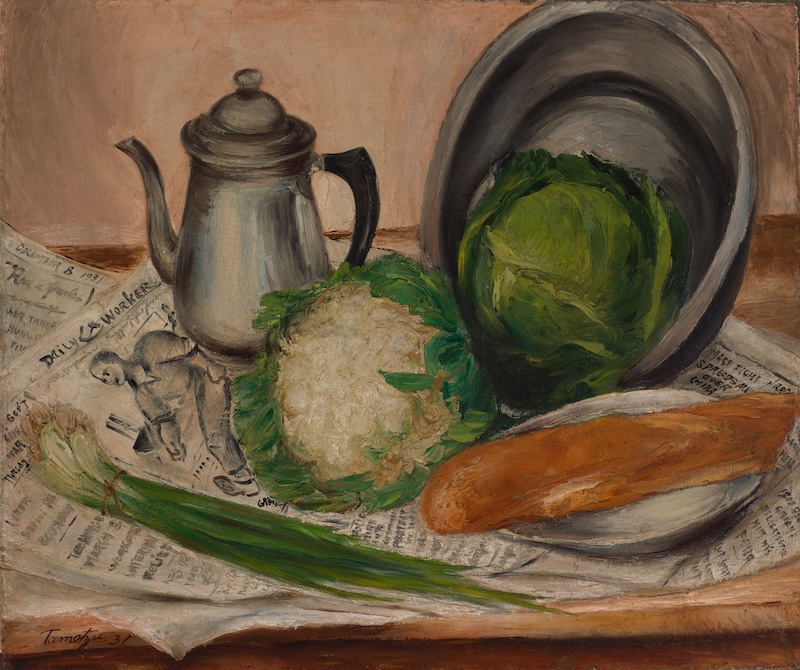Object of the Month: "Still Life with Newspapers" by Chuzo Tamotzu
By Bowdoin College Museum of Art
In 2021, the Bowdoin College Museum of Art welcomed the donation of seventeen works of art created by Chuzo Tamotzu (1888–1975), an American artist born in Japan, through the generosity of Helena Katz, a niece of the artist.
In June 2025 at the start of my summer internship at the BCMA, Co-Director Anne Collins Goodyear and I had an opportunity to meet Katz and another of the artist’s nieces, Bobbi Kates-Garnick, to discuss each work.
One painting in particular stood out to me: Still Life with Newspapers, created in 1931. The artwork features a newspaper prominently displayed among everyday objects. Yet the composition’s seeming simplicity is deceptive. It quickly became apparent to me that this was not a mere aesthetic exercise—it was a statement.
While the words that appeared written on the pages depicted in Still Life with Newspaper initially seemed illegible, coming together to study the works as a team, I saw the canvas anew. Gathered together, we observed that the newspaper in the still life reads: “December 8, 1931” and “Mass Fight Spreads Over China.” Depicted in the painting is not just any newspaper—it is the Daily Worker. Published by the Communist Party of the United States, the newspaper covered a wide array of topics including international affairs, civil rights, and labor issues. Tamotzu’s decision to position The Daily Worker as a central element—the very foundational undergirding of this composition—offers insight into the artist’s political leanings and his solidarity with anti-imperialist causes, particularly concerning his native country of Japan.
In the lead up to December 8, 1931, the Daily Worker condemned Japanese policy in Manchuria and its colonial expansion in areas such as China and Korea. At the same time, the publication championed the rights of the marginalized communities. Tamotzu's inclusion of this newspaper in his still life suggests an alignment on his part with its values and a desire to highlight the importance of these concerns. Several specific headlines are visible in the painting: “Mass Fight Against Imperialists Spreads all over China”; “Red International of Labor Unions Open Sessions”; and “Police Fire into Communist Protest in Warsaw, Poland.” Each of these correlates with the December 8th, 1931 issue of the Daily Worker.
The arrangement of objects, the color palette, and the overall composition contribute to the painting's message. The newspaper, as a source of information and a platform for dissenting voices, is juxtaposed with objects representing everyday life, suggesting the integration of political awareness into the domestic sphere. Tamotzu uses the still life genre not as a simple exercise in representation, but as a means of expressing his political convictions and inviting viewers to engage with the pressing issues of the moment. Tamotzu's connection to anti-imperialism, particularly in relation to Japan, adds another layer to the artwork. Born in Japan, but living in the United States, he likely held complex views on the relationship between these two nations. His choice to center the Daily Worker, a publication critical of both capitalist exploitation and imperialist aggression, suggests a desire to challenge the existing power structures and advocate for a more just world.
While living in Santa Fe, New Mexico—in the shadow of Los Alamos, the home of the Manhattan Project and its creation of the world’s first atomic weapons—Tamotzu would organize an exchange of drawings between children in Santa Fe, New Mexico, and Hiroshima, Japan; this effort was highlighted in a 2017 exhibition, Perspectives from Postwar Hiroshima: Chuzo Tamotzu, Children’s Drawings, and the Art of Resolution, and related symposium at the BCMA. Its offer of friendship and reconciliation was highlighted in Time magazine on May 11th, 1953. Again, Tamotzu’s artistic efforts expand the notions of world peace. This collaboration between the students of Japan and the United States testifies to the confidence he had that young people, raised in an era of atomic destruction, could heal political disputes and offer global peace. Throughout his career Tamotzu worked to promote international understanding and goodwill. This courageous artist, who, having traversed the world described himself as an “ageless wanderer,” understood that the influences of art surrounding themes of change, peace or reconciliation could transcend national boundaries.
Through his powerful and thought-provoking artworks, Chuzo Tamotzu sought to inspire a sense of shared humanity and a commitment to ending violence and promoting harmonious relationships between peoples across the world. Inspired by this conviction, Tamotzu’s art transcends political and cultural binaries, using visual expression to champion empathy and unity. Tamotzu reminds us that art can be a beacon of hope. This enduring message challenges the viewer to resist passivity and to engage actively with the construction of a compassionate and equitable future.
Mya Benally ’26Student Curatorial Intern